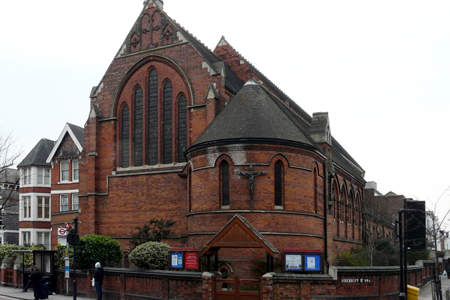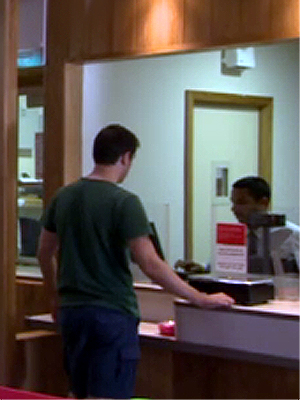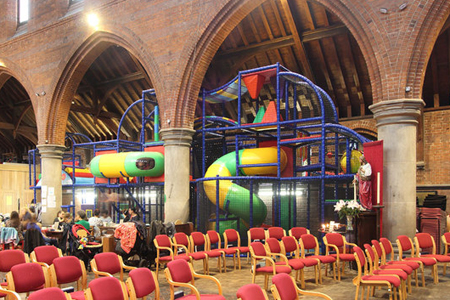| |
 |
 |
 |
| Comment on this report, or find other reports. |
 |
| Our Mystery Worshippers are volunteers who warm church pews for us around the world. If you'd like to become a Mystery Worshipper, start here. |
 |
| Find out how to reproduce this report in your church magazine or website. |
|
|
| 2915: St James West Hampstead, London |
 |

Photo:
Andrew Wood — London Churches in Photographs
|
 |
Mystery Worshipper: Cool Dude.
The church: St James West Hampstead, London.
Denomination: Church of England, Diocese of London.
The building: A sober red brick affair of 1887 in the early English Gothic style with narrow lancet windows. Designed by the 19th century architect Sir Arthur Blomfield, one of the last great Gothic Revivalists, it is architecturally correct but not especially friendly or lovable. The first thing that I noticed was the large Post Office sign. In November 2012 the local post office, faced with closure, invited local parties to register interest in being an outlet for postal services, and St James responded. Also catching my eye was a fabric banner declaring Hullabaloo. When you get to the doorway you find automatic sliding doors like those as you exit the airport customs hall. Passing through these, you encounter a second set of sliding doors that also automatically part. Once inside, I found my expectations further confounded by a large new post office counter. To my left, Hullabaloo turns out to be a huge brightly coloured climbing frame playground with shutes, bouncy cushions and rope bridges, occupying the whole of the north aisle, right up to the roof. It is a major visual intrusion (I wonder what the conservationist Victorian Society thinks?) – but if I were a four year old I would love it. Apart from the play equipment and post office there is also a café, which I was later told is crowded during the week, not least with mothers whose children are indulging in Hullabaloo. There is quite a lot of unecclesiastical furniture: sofas, displays of greetings cards, a gilt bedroom mirror, and a dresser with china on it plus a sign that reads: "Do do touch the crockery on this shelf" – was it for sale, or use, or decoration?
The church: St James is one of two churches in the parish, the other being St Mary with All Souls, Kilburn. The vicar, I later discovered, challenged the bishop head-on in 2014 when he married his male partner. (Doubtless the church hierarchy remains concerned by this, but I ardently hope they learn to live in comfort with it. Quite apart from the injustice of the Church’s attitude toward its gay and lesbian clergy, they cannot afford to lose the likes of Father Andrew.) Despite all the, erm, Hullabaloo, St James says that their worship style is traditional and reflective, rather formal in fact, and their preaching progressive. They are a bastion of Anglo-Catholic tradition (but see below). They also say that they set a high priority on social life. They have morning prayer each weekday except Thursday, and a said mass on Tuesdays, Thursdays and Fridays. The Sunday mass is a sung mass.
The neighbourhood: West Hampstead, when I first knew it in the 1970s, was genteel, downwardly mobile, bohemian and shabby. There was a notable Jewish population – quite a few holocaust survivors – and a Czech club near St James was a celebrated refuge for dissidents escaping communism in the Cold War years. Today, West Hampstead is bustling and has, like so much of London, a rapidly growing population. There is money here, but there is real poverty too. Some of the larger houses are converted into dozens of tiny bed-sits in which itinerant workers and those new to London live in cramped conditions at exorbitant rents. West Hampstead is ethnically and religious diverse. St James’s sits on West End Lane, a busy suburban thoroughfare a few steps from West Hampstead Underground and railway stations. Several busses run past. And so, although well out of the centre of the city, it is a well connected spot.
The cast: The Revd Andrew Foreshew-Cain, vicar (and postmaster!), and an unnamed cantor.
The date & time: Sunday, 30 August 2015, 11.00am.
What was the name of the service?
Sung Mass.
How full was the building?
When the mass started (late – Father had apparently been delayed at the other church) there were 18. A few more arrived after things began. Eventually the worshipping part of the church was comfortably full with 25. Somebody said it was quiet due to holidays – this was August Bank Holiday weekend.
Did anyone welcome you personally?
The two sets of automatic doors, surprising though they were, struck me as quite welcoming as they opened silently for me. The friendly woman on duty inside followed up with a human welcome and gave me the hymn book and sheet I needed.
Was your pew comfortable?
The modern upholstered seats were very comfortable and arranged semi-formally round the nave altar with plenty of space between rows – a good welcome continued.
How would you describe the pre-service
atmosphere?
People were quietly attending to business and post-service catering, so I sat alone in the worship area until everyone came together. It seemed as though people felt it was their building. I had a few minutes to contemplate the interior with its eclectic mix of play equipment and tabernacle, sofas and hanging sanctuary lamps, post office counter and elaborate Victorian chancel screen.

Photo:
bbc.com - © 2014 BBC
What were the exact opening words of the
service?
"Father Andrew is on his way from St Mary’s and we will get things going with our opening hymn."
What books did the congregation use during the
service?
New English Hymnal, a weekly notice sheet and the mass booklet. This was pleasantly large – each page a full A4 size, spaciously and clearly laid out. How refreshing – no squinting at tiny handouts.
What musical instruments were played?
A Victorian organ, some way past its prime, accompanied our hymns. At communion the organist moved to a piano – also an elderly instrument. On this he somehow managed some beautifully serene Bach.
Did anything distract you?
Several plastic carrier bags were in front of the altar. I should have guessed it sooner, but they were offerings brought by the congregation for the local food bank.
Was the worship stiff-upper-lip, happy clappy, or
what?
Modern Anglo-Catholic, reverential and simple. No altar party, apart from the cantor. No incense or frills. It felt right. The parts of the mass were sung to well known hymn tunes (for example Abbots Leigh and Evelyns), which is much easier for a congregation than the beautiful but challenging cadences of plainsong. By the time we got to the gospel, Father Andrew had still not arrived from the other church, so our cantor ably stood in. Just as I thought he would have to give the homily too, Father processed briskly up the south aisle and took his place to preach.
Exactly how long was the sermon?
11 minutes.
On a scale of 1-10, how good was the preacher?
8 – Assisted by an excellent sound system, Father Andrew was able to use a conversational voice. His sermon, though thoughtfully prepared, was like a personal dialogue with his people.
In a nutshell, what was the sermon
about?
He connected our readings to the international crisis of mass migration and movement of asylum seekers that had come to a head in that week’s news (a truckload of 71 dead bodies of Syrian asylum seekers had been found in Austria). One in four people in Lebanon were now displaced refugees. Luther dismissed James' epistle (from which one of today's readings is taken) as an "epistle of straw," doubting its canonicity. But he later retracted his words. So let us consider with James: "You must do what the Word tells you and not just listen to it and deceive yourselves."
Which part of the service was like being in
heaven?
The welcome – at the door on arrival, at the exchange of peace in the mass, at the gathering afterwards, and in the general atmosphere.
And which part was like being in... er... the other place?
Nothing – not even Hullabaloo!

Photo:
© John Salmon and used under license
What happened when you hung around after the service looking lost?
No opportunity to look lost. Father Andrew welcomed me as I returned my hymn book and invited me to coffee at the nave café. Here several people spoke to me and made me feel a welcome visitor. I chatted to a member of the congregation, who turned out be 19 years old, whose second visit this was. He had just arrived in London the previous week to start a new job. London is increasingly a city of newcomers and strangers, and churches don't always acknowledge this with an open welcome of the quality I found here.
How would you describe the after-service
coffee?
Filter coffee or tea in china mugs and – a treat for this Sunday, I think – a delicious home-made coffee and walnut cake.
How would you feel about making this church your regular (where 10 = ecstatic, 0 = terminal)?
8 – If it were nearer to home I’d be back next week.
Did the service make you feel glad to be a
Christian?
Absolutely – and pleased to be among others.
What one thing will you remember about all this in seven days' time?
The warmth of welcome. |
|
|
 |
 |
 |
| We rely on voluntary donations to stay online. If you're a regular visitor to Ship of Fools, please consider supporting us. |
 |
 |
 |
| The Mystery Pilgrim |
 |
| One of our most seasoned reporters makes the Camino pilgrimage to Santiago de Compostela in Spain. Read here. |
 |
 |
 |
| London churches |
 |
| Read reports from 70 London churches, visited by a small army of Mystery Worshippers on one single Sunday. Read here. |
| |
|
|
|
|


